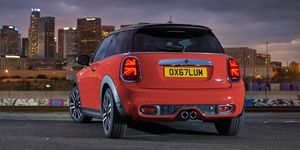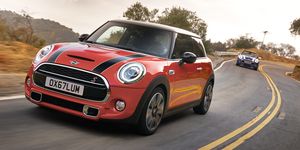If you’re thinking of stuffing your entire family and belongings into a car, you’re probably not shopping a brand named Mini. But, both the Mini brand and Mini’s cars have steadily grown since the brand relaunched in 2003, and there are now two plumped up and not-so-Mini crossovers for sale at Mini stores. The Countryman and the Clubman are the largest choices in Mini’s lineup, and despite their size, each has the iconic look and smaller-is-better character that exemplifies the brand. We gathered both to compare the differences, to parse the good and the bad with the goal of learning which one is better.
The Matchup
Despite our classifications—in our eyes the Countryman is an SUV and the Clubman is a station wagon—both are more or less mid-size hatchbacks. The Countryman is taller than the Clubman, but they are nearly the same length. Both share design traits and a familial connection to the two-door Cooper Hardtop, but their larger size means they each have a lot more cargo and passenger space. The big Minis are also similarly priced. The Countryman S starts at $33,250 for a front-wheel drive base model while the Clubman starts at $31,750.
For this comparison, we chose front-drive versions of the 2020 Countryman S and a 2020 Clubman S. Mini offers an all-wheel drive (dubbed ALL4) on both the Countryman and the Clubman. Both test cars came well equipped. The Iconic Trim package, which costs $8000 on either the Clubman or the Countryman, loads these Minis with adaptive dampers, power-folding exterior mirrors, panoramic sunroof, a Harman/Kardon stereo system, and the touchscreen Navigation package that bundles in-dash navigation, Apple CarPlay, and a wireless smartphone charging pad. Both also came with the best-avoided Driver Assistance package that adds parking sensors, adaptive cruise control, and a self-parking feature for another $850 on either car. We like to drive, and paying extra for unneeded nannies is not something we want to do. Total it up, and the Clubman arrived with a $40,600 price and the Countryman asked for a cool $42,250. Mini presents itself to be a premium small-car brand, and as equipped, these maxi Minis’ prices are a clear reach into the luxury sphere.
On the Road
Minis are best known for being fun to drive, for having the ability to cut and thrust, for being able to find holes in traffic that other cars can’t, and for lively and quick steering. Despite being a size up on the “fun size” Minis, the Countryman and Clubman successfully translate a good amount of friskiness to a bigger footprint. Steering is direct and communicative in both vehicles. The lower-riding Clubman, which is essentially a stretched Cooper Hardtop, felt particularly sharp and eager to change directions at the slightest provocation. That liveliness can feel darty and jittery at highway speeds, something commuters should note, but it’s very much the driving enthusiast’s choice here. The Countryman, which is on larger platform shared with the BMW X1 and X2, isn’t as sensitive and relaxes more readily than the Clubman.
The Clubman S and the Countryman S are both powered by a 189-hp turbocharged 2.0-liter four-cylinder engine that’s mated to a seven-speed dual-clutch automatic transmission. At the track, the 185-pound lighter Clubman outsprinted the Countryman. The Clubman hit 60 mph in 6.4 seconds, and the Countryman needed 6.8 seconds to get there, which is still brisk compared to other small luxury SUVs. The Countryman won the deceleration contest with an impressive 157-foot stop from 70 mph, the Clubman was close behind at 160 feet.
Judging by EPA estimates, both are reasonably fuel efficient, but the lower, lighter Clubman wins again with ratings of 26/34/29 mpg city/highway/combined. The Countryman carries ratings of 23/32/26 respectively. We put both of them through our 200-mile highway fuel economy test where the Countryman matched its 32 mpg EPA highway rating, and the Clubman returned an impressive 36 mpg.
The Inside View
If you enjoy Mini’s arcade-like interior design, you’ll feel at home in the Countryman and Clubman. We find the many shapes, materials, and lighting dizzying and overwrought. We realize that Mini is trying to be playful and youthful, but this treads into tacky and childish especially at these as-tested prices. Sure, you can turn off the rainbow of LEDs that light up the top half of a giant circle smack in the middle of the dashboard, but why is it there in the first place? Within that circle is a rectangular infotainment-system screen that’s a reminder that a round screen that would fill the space was probably too expensive. The Countryman’s higher roof lends an airiness to the cabin that the Clubman can’t match, and according to the measurements, there’s a little more passenger space in the Countryman, particularly in the rear seat. The Countryman’s rear-door openings are wider as well, making it easier to get in and out or install a child seat.
When it comes to carrying cargo, these two are remarkably similar. Both accommodated the same number of carry-on suitcases in our testing. Five fit behind the rear seat , and 16 can be loaded in with the rear seats folded. The doors to the cargo area are different. The Countryman has a traditional liftgate that swings up and out of the way, while the Clubman has what Mini calls Club doors. The Clubman’s doors are a sort-of-French-door arrangement that requires the right side to be open before the left side can be unlatched. Worse, where the door frames come together, they obscure the view out the rear window because it’s divided down the middle. We also noted that the Clubman’s two tiny rear wipers are less effective at clearing dirt and water than the Countryman’s single large wiper.
The Bottom Line
Both big Minis are eager drivers, they both offer similarly cheeky styling, and the interiors are so similar it’s hard to remember which one you’re in when switching back and forth. The bottom line here is that choosing one or the other boils down to whether you want a car or a crossover. But, you should know that the Countryman isn’t much larger inside, it has no cargo capacity advantage, and while it sits higher, the view out isn’t particularly commanding.
As enthusiasts and lovers of handling and performance, we’d pick the slightly quicker and sharper Clubman S. It’s more efficient and similarly practical when compared to its SUV-ish sibling, we’d just have to get used to the Clubman’s wacky rear-door design.
Not that we’re sold on either. The bigger a Mini gets, the more it strays from the Mini brand’s reason for existing. But, it is still a Mini, so it’s still too small to work as well as an SUV or station wagon. For the price, rivals such as the Volvo XC40 SUV or V60 wagon and the mechanically similar BMW X1 and X2 SUVs are vastly more appealing and practical. But if you want something a little smaller, a little sportier, and a little more fun, we’d go with the Clubman.
Source: Reviews - aranddriver.com







